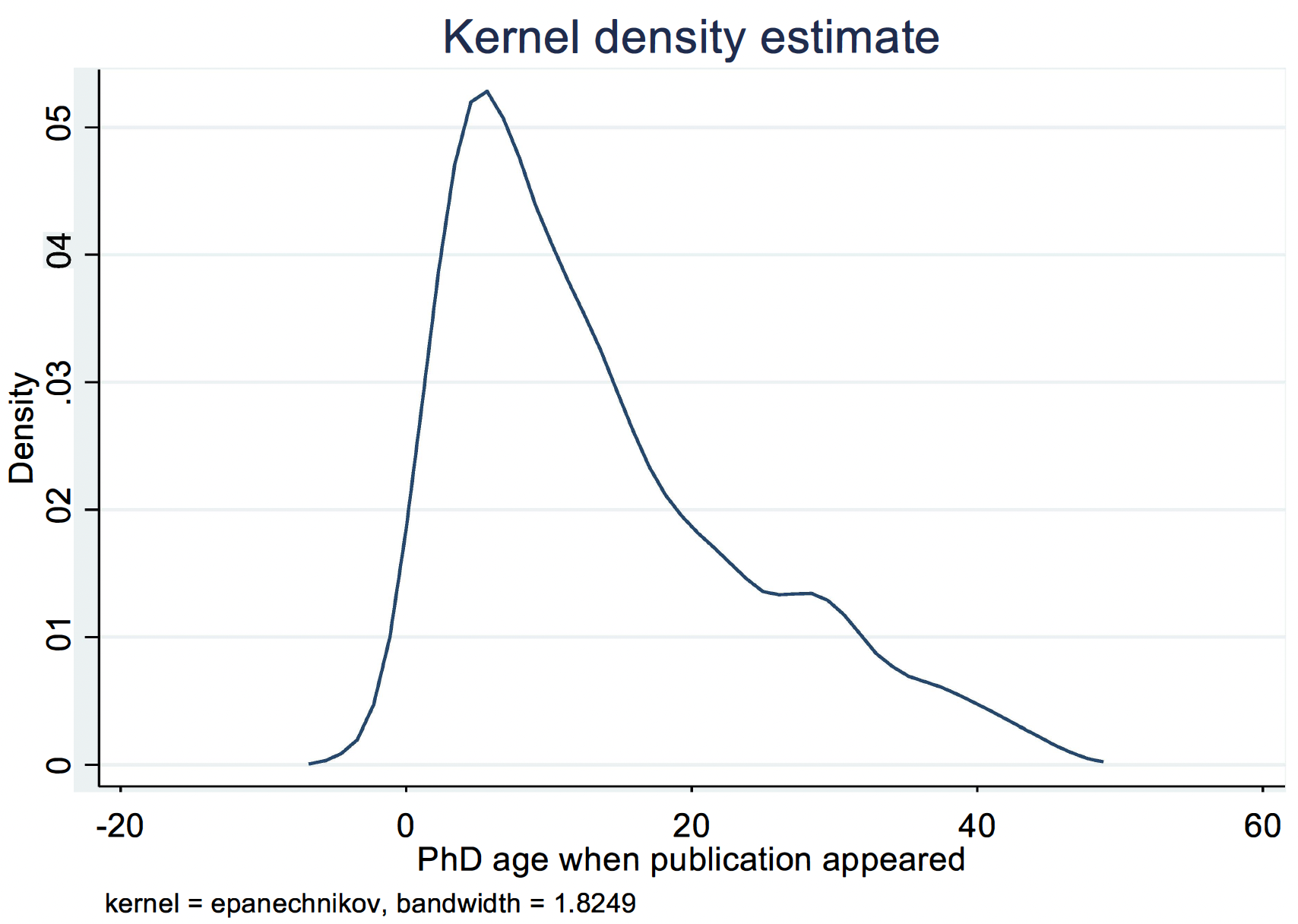The arc of creative activity may be inverse-V-shaped in age – rising quickly and then declining.
This has been observed casually for centuries (for example, in the careers of such mathematical and scientific geniuses as Niels Henrik Abel, Srinivasa Ramanujan, and Werner Heisenberg). The sciences and mathematics are especially noted for prodigies. Similar youthful productivity is observed among artists like Picasso and Matisse, but these geniuses maintained phenomenal creative activity into old age.
Despite some people’s claims (hopes?), economics is not a science; but neither is it art. The ‘what’ issue then is: Does creativity in economics peak early, as in mathematics or science, or instead, as with Picasso and Matisse, does it rise quickly and stay at the frontier over much of an economist’s career before declining?
The ‘why’ issue is much tougher to answer: If the rate of top-level publication does slow down, what might be causing economists’ creative juices to diminish fairly early in their lives?
We scanned the entire texts of all articles published in the ‘Top Five’ economics journals
between 1969 and 2018, keeping records on all 1,389 authors who appeared in these journals at least five times during this period and on their nearly 13,000 publications in these journals. We also obtained these authors’ ages, noting that 359 of them received their doctorates between 1969 and 1978 and thus had careers of 40–50 years to publish in these most visible outlets.
This group – the ‘1970s cohort’ – accounted for the most successfully published economics PhDs of that vintage, but fewer than 5% of all economics PhDs awarded in that decade. They had 3,562 articles in this dataset. Nearly a quarter of these authors had only five such papers, and one person published 48 times in these outlets.
Each article was evaluated in a content-analysis programme to measure its semantic style along the following criteria: its net positivity (positive minus negative words and word phrases), its net certainty (certain minus tentative words), and its net contemporaneity (present and future verb-tense usage minus past tense). The majority of articles were written in a net negative style, and nearly all had net feelings of tentativeness and contemporaneity. (Economists really are dismal, as well as three-handed.)
Finally, we obtained the total citations (through August 2021) to these articles, viewing citations as the best objective measure of the impact of scholarly work on other scholars and on the world generally – of the productivity of economic research.
We already knew from a small cross-section of top-level economics articles that the typical author was quite young (Hamermesh 2013). In our comprehensive sample, we see the same thing: Figure 1 indicates that the modal PhD age at publication in the 1970s cohort was 10 years (and it was the same among economists who received a PhD in the 1980s or 1990s).
Figure 1 Kernel density estimate of the distribution of authors’ PhD ages, star authors 1969–78 cohort, ‘Top Five’ journals, 1969–2018
Even more striking is the fact that, in this cohort, fewer than 20% of the articles in the most prestigious outlets appear more than 20 years after the scholars received their doctorates. Publishing top-level economics is a young person’s game. In other words, economists appear to echo Abel more so than Picasso. But can we shed more light on why this is so?
Some clear patterns are visible when we look at the number of articles published in each decade of this cohort’s careers. To discern these patterns, we estimate autoregressions describing each scholar’s decadal publication total, as determined by the number, style of, and citations to her/his previous decade’s publications. These autoregressions show that those who published less in the previous decade of their career publish less in the current decade. And that autoregression becomes stronger as careers pass – success increasingly breeds success.
Also, those whose recent work has been more heavily cited publish more. Although only weakly statistically significant, scholars whose recent articles have a more positive, and especially a more tentative tone, have greater subsequent publishing success.
There are many possible reasons why these leading scholars might fade ‘out’ (by our quite stringent definition requiring publication in these top journals), including:
- decreasing incentives to publish top-flight work (smaller salary gains with greater seniority)
- the attraction of other activities – academic administration, consulting, politics, and others
- boredom
- declining mental ability
- increasing departures from the profession’s current focus, perhaps due to technological obsolescence, and perhaps leading to editors’ declining interest in publishing one’s work.
That a relative lack of recent citations reduces one’s current research output suggests the likely importance of this last possible reason. In the end, however, we cannot distinguish among these; we can only observe the proximate causes of the slowdown.
We also obtained information from the authors’ CVs on the career status of the 1970s cohort members in 2018, when most of them were at least of statutory retirement age. Of the 89% of authors who had remained in academia for almost their entire careers, 31% had retired by 2018. Those scholars published only two articles in these journals after retirement – they were no longer publishing at this top level. Being in a country with mandatory retirement rules was a very strong predictor of whether the scholar was retired (nearly twice the retirement rate of other similar scholars).
Most interestingly, those who had published more top-level research in their third decade were less likely to be retired. Indeed, authors who published 4+ articles in these journals in their third decade (12% of the cohort) were 22 percentage points less likely to be retired than the 35% of authors who had published nothing in these outlets during that decade. Moreover, even accounting for the number of recent publications, those whose publications were less-well cited were more likely to be retired.
One might think that these findings reflect mere correlation, not causation. If so, another method of departing academia – death – might also be related to them. It is not. Death is unrelated to prior scholarly productivity. Taken literally, the phrase ‘publish or perish’ is incorrect and the two (happily) are not substitutes. Apparently, the lack of top-level publishing success and the relative lack of recognition are what encourage previously highly productive scholars to retire.
We stress that, barring possible ‘golden handshakes’ (which our experience in academia suggests are at best silver, occasionally lead), retirement for most of these scholars is voluntary. Why retire, given that the burdens of remaining in academe are hardly onerous?
One reason is the defined-benefit pensions that exist in many countries and in some parts of American academia, which reduce people’s lifetime wealth if they postpone retirement. Another might simply be the demand for leisure – enjoying one’s remaining time with a retirement income typically well into the top quintile of incomes.
Perhaps previously highly productive senior scholars increasingly feel out of place among their more productive younger colleagues. At this level of scholarship, prestige becomes an important reward. And except for the most successful of these productive, successful scholars (perhaps the 15 Nobel Prize-winners in this cohort), prestige declines with age.
To paraphrase Woody Allen in his 1975 Love and Death, life is full of misery, loneliness, and suffering – and it’s all over much too soon. This is partly true about top-level economics publishing: it is mostly lonely work, and it is typically over even among very successful scholars quite early in their careers, as in the sciences and mathematics.
Given this depressing prospect, why bother? The answer is that trying to produce and publish top-level research is full of fun, not suffering (and the pay is more than adequate). And we feel that our efforts just might have a beneficial influence on society.
References
Checchi, D, A Ciolfi, G De Fraja, I Mazzotta, and S Verzillo (2021), “Have you read this? An empirical comparison of the British REF peer review and the Italian VQR bibliometric algorithm”, Economica 88(352): 1107–29.
Hamermesh, D (2013), “Aging and productivity”, VoxEU.org, 20 February.
Hamermesh, D (2015), “‘Measuring success in economics”, VoxEU.org, 14 December.
Hamermesh, D, and L-R Kosnik (2023), “Why do older scholars slow down?”, NBER Working Paper 31175.
Lehman, H (1953), Age and Achievement, Princeton University Press.




